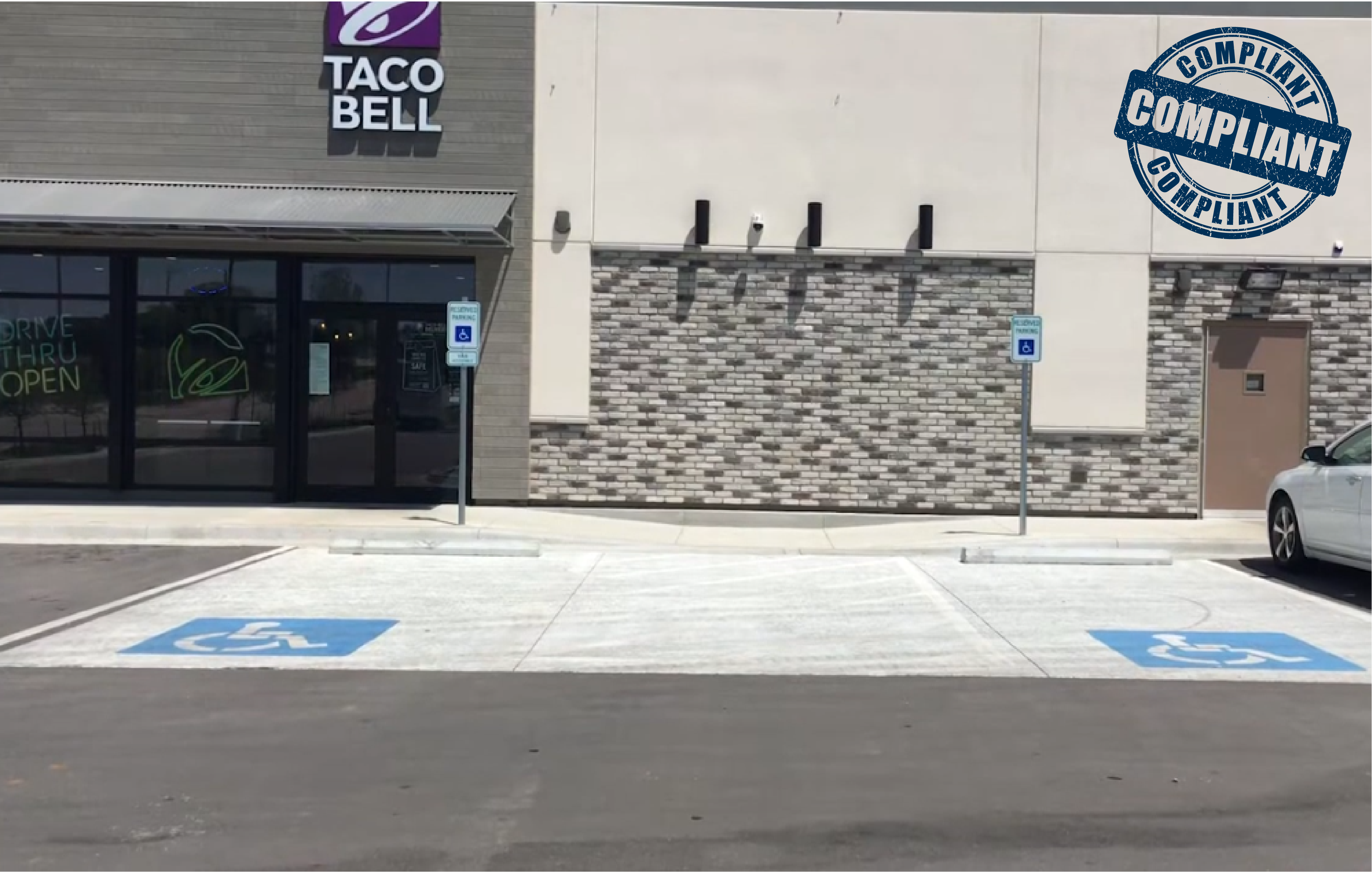Commercial & Public Right-of-Way ADA Compliant Regulations

The Americans with Disabilities Act (ADA) was passed into United States law on July 26, 1990, which “prohibits discrimination and guarantees that people with disabilities have the same opportunities as everyone else to participate in the mainstream of American life.” Title III of ADA requires new construction and alterations involved with commercial facilities to conform to the ADA Standards for Accessible Design. These standards are what our civil engineers and surveyors reference when conducting ADA-related job functions. It is our utmost priority to promote accessibility in our design, keeping equity and inclusion at top of mind throughout the process. Title III is only one of the different subsets under the act that concern private and public developments.
Local municipalities, business property owners, and other business operations that are highly interactive with the public must now focus greater attention on the accessibility of facility structures and make sure these features are up to current standards. While updates to ADA standards continue, there are key components to be aware of that could mean the difference between compliance and receiving a violation due to outdated or unsafe ADA conditions.
Setting the Standards
It’s important to periodically confirm that a development is up to code since new revisions to the standards continue to be put into action. As civil engineers and surveyors, our work deals with accessible design and redefining boundaries for existing properties with outdated or failing ADA compliance features. The ADA Standards for Accessible Design on a private site are different from those concerning public entities and public right-of-way.
Many reasons ADA compliance continues to change is because we’re still learning the best methods of success in preparing spaces for disabled persons. Transitioning spaces to be more accommodating brings up the question of where ADA compliance updates end. Many developments across the country are still in need of updates to accommodate those affected. Public right-of-way construction updates pose the greatest challenge since sidewalks and ramps can span for miles. Updates are made on a public works construction basis and municipalities must tackle ADA non-compliance issues when planning for new city construction.
ADA affects anyone who owns, designs, or constructs facilities that provide public access. This also means that private businesses can still be bound by ADA regulations based on a few factors, with firm size as one of the top considerations. If you are unsure where your property stands, the best practice for ADA compliance is to assume you will be liable for any violations in areas that aren’t restricted.
Across the project timeline, there are key periods that ADA compliance inspections tend to factor into the process. In both commercial and public projects, the local authority may consider it a requirement for their approval in the design process before a development can move forward. With existing developments, the law requires reasonable modifications to be made wherever possible so that the greatest number of individuals can be served. The inspection process mainly comes into play when components that require ADA compliance are modified. This includes features such as doors, doorways, wheelchair-accessible ramps to entryways, and walking surfaces.
Buyers Beware
One area to be aware of when looking at buying an existing development is keeping an eye on where ADA non-compliance issues surface during the inspection and acquisition process. The traditional areas of concern that most future property owners assess are the conditions of items like HVAC systems, water heaters, roofing, and parking… but what about ADA compliance? Sellers are not required to disclose information related to ADA non-compliance. This means that on the first day of owning a new property falling under the ADA compliance regulations, the owner is liable for any fines or lawsuits that come about from ADA violations. It is suggested to inspect the ADA features and make the seller aware of any issues before buying a property. BHC’s ADA audits have the ability to catch violations that hold you accountable and find design solutions to the problem.
Developing or modifying a new property and repairing public right-of-way can undoubtedly become pricey. When going through the checklist of ADA compliance measures, it’s too often that property owners hold off on making the necessary changes at the preliminary stages of development which can result in inevitable repairs, wasted time, and possibly even costly ADA compliance violations later. While it may be human nature to put the question of ADA compliance on hold, hiring services like BHC’s ADA audits and surveys will be sure to ease the minds of project managers and property owners.
In Need of ADA Compliance Services? No Problem.
With the constant changes to ADA compliance requirements, sometimes the lines become blurred on where responsibilities lie with ADA-compliant properties and public rights-of-way. As a full-service firm, our different segments are knowledgeable and able to handle customers’ needs up to the building design. No matter what stage a development is in, BHC offers different ADA compliance services within our Survey and Development segments.
For developments that are underway and in need of a survey for design, BHC’s Survey team is able to deliver survey results to best go about initiating plans for the repair. These surveys get down to the accuracy of an elevation to better understand if a location meets the specifications. When evaluating existing properties in need of potential ADA compliance changes, a topographic survey can provide in-depth surface features and elevation mapping to assess as-built designs. ADA surveys evaluate the angle at which a sidewalk curb ramp is situated. If the angle does not fall within the acceptable range of slope, it violates ADA regulations.
One of the biggest challenges with ADA compliance is understanding how a facility is going to be used and by who. It is necessary to work with the owner and possibly the users to understand the needs of the development. Our Development experts are able to aid in ADA compliance developments through audits. It is our goal to work with customers to find solutions to ADA non-compliance issues, all while minimizing impact to facility operations and finding cost-effective solutions that thoroughly address the problems. When performing ADA audits, our team visits a site to take measurements and evaluate the site in question. BHC’s civil engineers can then take the findings and implement design strategies to turn around a non-compliance issue.
Whether you’re looking to assess an existing property or conduct a survey to help isolate and measure a space from point A to B, BHC’s ADA services have you covered. Connect with one of our experts today to get your next project up to ADA standards and eliminate your risk of violations.
